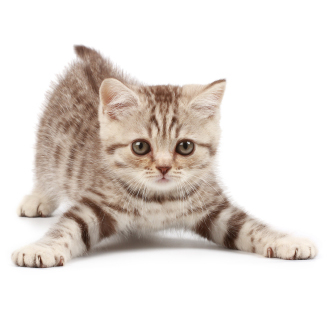Neutering your Cat
Why castrate a male cat? / Why spay a female cat?
MALE CATS
We advise that male cats should be neutered (castrated) unless they are intended for breeding. We perform this operation at about six months of age.
Why castrate a male cat?
Mature male cats develop a very intense smell that makes it very difficult to share a home with them – it resembles the strong odour of a tiger cage in a zoo. Castration at the right age prevents this smell developing, and you and your tom cat can continue to live happily together.
Part of the normal behaviour of mature male cats is to spray urine to mark their territory. As this is part of normal behaviour, it is not possible to train a cat not to do this – and the urine will smell intensely. Castration prevents this behaviour.
Entire tom cats tend to roam widely and also fight with other cats, making them very prone to accidents and injuries / abscesses from fighting. They also commonly pick up infections such as FIV (‘cat AIDS’) or feline leukaemia virus (FeLV). Castration reduces the urge to roam and fight, but will have no effect on the general personality of a cat.
Entire male cats are responsible for fathering a lot of unwanted kittens. Only some of those are lucky enough to find loving homes – far too many will not survive for long. Having your tom cat castrated will make sure that he does not add to this problem.
There is a very small risk associated with performing any operation under general anaesthesia – this is the case for every operative procedure. Otherwise no health or other problems have been reported due to castration.
Castrated cats tend to need fewer calories, which means there can be a tendency for them to put on weight. Being aware of this and feeding them with an eye on their waistline will prevent extra weight gain. There is no automatic increase in weight due to the castration, it all comes down to giving the correct amount of food.
How do I arrange to have my cat castrated?
The first step in having your tom cat castrated is to arrange an appointment. In many cases we will know your cat already because he would have come to us for his vaccinations. In that event you can often just book an appointment for the operation. If we have not seen your cat before we will ask to see him for a normal appointment first to perform a general health check. This is done to make sure that he is healthy enough to undergo general anaesthesia and to ascertain that both testicles are sitting in their normal anatomical position.
It is very important that he is starved the night before the surgery and that he has nothing at all to eat on that morning. If there is any food in the stomach, the anaesthetic risk is higher than usual, so this point cannot be overemphasised.
Initially your cat will be given a so-called premedication, which contains a sedative and a strong pain killer. He will then be anaesthetised and the testicles will be removed. He will be left with two small wounds at the bottom end, which are usually not sutured as they quickly close on their own. After waking up, your cat can go home on the same day, usually in the afternoon. He may still be a bit ‘light-headed, but should be fully awake. He can eat a small light meal and should just be allowed to rest.
FEMALE CATS
We advise that female cats that are not definitely intended for breeding should be neutered (spayed) at about 6 months of age. At this time they are due to come into season for the first time.
Why spay a female cat?
Female cats are very successful at finding mates and as it is not easy to keep cats indoors during their season – the chances are high that they will come home pregnant! The care and costs necessary to raise several kittens and to find loving homes for all of them is generally more difficult than people anticipate and can be avoided by having female cats spayed at the right time.
Cats come into season every two to three weeks, especially during spring and summer. They do not bleed like dogs but usually show behavioural changes. Cats in season will rub against both objects and people, roll on the floor and cry or even howl constantly. This personality change can be so dramatic that people frequently rush their cat to the vet thinking that she must be ill or in pain. As it can last for several days each time the cat is in season, it is not easy to live with an un-spayed cat.
Mating and being around un-castrated fighting tom cats will put a female at risk of injury from cat fights and infections such as feline leukaemia virus (FeLV) and FIV (‘cat AIDS’).
Un-neutered female cats tend to have several litters each year, which puts an enormous strain onto their bodies. This means that the life expectancy of such individuals is lower than that of spayed female cats.
There is a very small risk associated with performing any operation under general anaesthesia – this is the case for every operative procedure. Otherwise no health or other problems have been reported due to spaying.
Spayed cats tend to need fewer calories, which means there can be a tendency for them to put on weight. Being aware of this and feeding them with an eye on their waistline will prevent extra weight gain. There is no automatic increase in weight due to spaying, it all comes down to giving the correct amount of food.
How do I arrange to have my cat spayed?
The first step in having your cat spayed is to arrange an appointment. In many cases we will know your cat already because she would have come to us for her vaccinations. In that event you can often just book an appointment for the operation. If we have not seen your cat before, we will ask to see her for a normal appointment first to perform a general health check. This is done to make sure that she is healthy enough to undergo general anaesthesia and an operation.
It is very important that she is starved the night before the surgery and that she has nothing at all to eat on that morning. If there is any food in the stomach, the anaesthetic risk is higher than usual, so this point cannot be overemphasised.
Initially your cat will be given a so-called premedication, which contains a sedative and a strong pain killer. She will then be anaesthetised and the uterus and ovaries will be removed through a small incision which is usually made on the flank. In rare cases, especially with certain cat breeds or when a small hernia is present, we will advise that the operation is performed through an incision made on the underside of the tummy rather than the flank. Afterwards the wound is stitched, usually with sutures that are not visible on the outside. After waking up, your cat can go home on the same day, usually in the afternoon. She may still be a bit ‘light-headed’, but should be fully awake. She can eat a small light meal and should just be allowed to rest.
We advise that you keep your cat indoors for about 10 days and to make sure that she does not lick the wound, as this would delay healing or even lead to opening of the wound. Most cats leave well alone, but if necessary she will have to wear an Elizabethan collar to prevent damage to the wound. It will take 10 days for the wound to heal fully and it is important that you monitor your cat well during that time. We will ask you to bring her for a postoperative check-up appointment 2 days after the operation. Should anything look unusual or should you be unsure about anything at all before or after the appointment, you should contact us for advice.




